Lyme Regis
| Lyme Regis | |
| Dorset | |
|---|---|
 Lyme Regis | |
| Location | |
| Grid reference: | SY337922 |
| Location: | 50°43’30"N, 2°56’24"W |
| Data | |
| Population: | 4,406 (2001) |
| Post town: | Lyme Regis |
| Postcode: | DT7 |
| Dialling code: | 01297 |
| Local Government | |
| Council: | Dorset |
| Parliamentary constituency: |
West Dorset |
| Website: | lymeregis.org |
Lyme Regis is a pretty, coastal town in the very west of Dorset, standing on Lyme Bay, on the English Channel coast. It is a town known for seaside holidays and fossils; indeed in the shops of Lyme one is as likely to find an ammonite as a bucket and spade.
The town stands 25 miles west of Dorchester and 25 miles east of Exeter. The Devon border is at the edge of the town, just a third of a mile west of the harbour.
Lyme is nicknamed "The Pearl of Dorset." The seafron of the town consists of two parts; the centre of the town is where Broad Street tumbles down to the sea, while to the west of the harbour, with its own centre, the seafront between the two filled with hotels, B&Bs, holiday facilites and grand residences, while lining the top of the beach is a herd of beach huts.
One of the most famous sights of the town is the harbour wall, "The Cobb", which features in Jane Austen's novel Persuasion, and in the book and film of The French Lieutenant's Woman, a novel by local writer John Fowles.
The town was home to Admiral Sir George Somers, its one time mayor and parliamentarian, who founded the Somers Isles, better known as Bermuda.
The town's population at the 2001 census was 4,406, 45% of whom were retired.
Fossils
Fossils are found frequently in the cliffs and beaches, and indeed it is at Lyme Regis that fossil-hunting began. The cliffs are particularly rich in fossils due to their structure their and habit of collapsing, revealing the leavings of past ages amongst the broken rock. The legacy of long ago ages is seen in the rock of the town; even the randomly hewn stone of the Cobb shows the shapes on ancient fish in it.
Mary Anning (1799–1847) lived in Lyme, and she it was who pioneered the finding and classifying of fossils and her work revolutionised the study of palaeology. She discovered many types of dinosaur before the dinosaurs themselves had a name. It was amongst the cliffs of Lyme Regis in the winter months that she made her greatest discoveries. Her discoveries included the first ichthyosaur skeleton to be correctly identified, the first two plesiosaur skeletons ever found, the first pterosaur outside Germany and some important fish fossils.
Today the coatline is known as "the Jurassic Coast", and is designated a World Heritage Site. The Jurassic Coast stretches over a distance of 95 miles (153 km), from Orcombe Point near Exmouth, in the west, to Old Harry Rocks, in the east.[1] The coastal exposures along the coastline provide a continuous sequence of Triassic, Jurassic and Cretaceous rock formations spanning approximately 185 million years of the Earth's history. The localities along the Jurassic Coast include a large range of important fossil zones.
The town now holds an annual Mary Anning Day and Lyme Regis Fossil Festival. A fossil of the world's largest moth was discovered in 1966 at Lyme Regis. There are fossil shops in the town, selling fosils both local and from further afield, and the usual mass-market shark's teeth and pretty minerals.
History
Lyme is mentioned in the Domesday Book of 1086. In the 13th century it developed into one of the major British ports. A Royal Charter was granted by King Edward I in 1284, with the addition of 'Regis' to the town's name. This charter was confirmed by Elizabeth I in 1591.
In 1644, during the Civil War, Parliamentarians here withstood an eight week siege by Royalist forces under Prince Maurice. In 1685, it was at Lyme Regis that the Duke of Monmouth landed to start the Monmouth Rebellion.
The Cobb was built at some time in the Middle Ages, though not in its current form. The first written mention of the Cobb is from 1328, but as a wall of oaken piles and heaped stones. The Cobb of today was built in 1820.
By the Napoleonic Wars, Lyme Regis was a busy and prosperous port.
Mary Anning was born here in 1799 and from early years she searched for fossils amongst the tumbled rocks below the cliffs east of the town. After the publication of her discoveries, palaeologists came to recognise this coast as a rich source of the fossils needed to uncover the ancient history of the Earth.
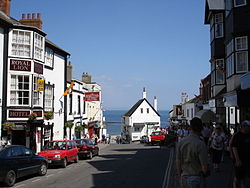
In 1965, the town's railway station was closed, as part of the Beeching Axe. It was rebuilt at Alresford, on the Mid Hants Watercress Railway in Hampshire. The route to Lyme Regis had been notable for being operated by aged Victorian locomotives, one of which is now used on the Bluebell Railway in Sussex.
In 2005, as part of the bicentenary re-enactment of the arrival of the news, aboard the Bermuda sloop HMS Pickle, of Admiral Nelson's victory at the Battle of Trafalgar in 1805, the actor playing the part of Trafalgar messenger Lieutenant Lapenotiere was welcomed at Lyme Regis.
River Lim
The town has grown around the confluence of the short River Lim (or Lym) with the sea. The Lim drops from the plateau at around 200m before flowing around 5-6km south and southeast to its mouth. Its name is of British origin and is likely cognate with Welsh 'llif' meaning 'flood', 'stream'.[2] Historically there were various mills along its length. Its lower reaches are followed by sections of three recreational paths; the Wessex Ridgeway, Liberty Trail and East Devon Trail.[3]
Landslips
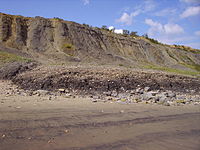
To the southwest of Lyme Regis lie Poker's Pool, Seven Rock Point and Pinhay Bay, to the northeast lies Charmouth. The coastal region near Lyme Regis is subject to large landslips. This means that Jurassic age fossils are regularly exposed and can be found on the beaches, but also causes devastation to the town.[4]
One of the most spectacular landslips occurred on 24 December 1839, 3 miles west along the coast in Devon belonging to Bindon Manor and known as "The Dowlands Landslip". About 45 acres of fields growing wheat and turnips were dislodged when a great chasm was formed more than 300 feet across, 160 feet deep and three-quarters of a mile long. The crops remained intact on the top of what became known as "Goat Island" among the newly formed gullies. On 3 February 1840, five weeks later, there was a second landslip nearby but much smaller than the former. This phenomenon attracted many visitors, and the canny farmers charged sixpence for entrance and held a grand reaping party when the wheat ripened.[5] The area is now known as The Undercliff and is of great interest because of its diverse natural history.
In 2005, work began on a £16 million engineering project to stabilise the cliffs and protect the town from coastal erosion.[6] The town's main beach was reconstructed and re-opened on 1 July 2006. On the evening of 6 May 2008, a 1,312.3 feet (400.0 m) section of land slipped onto the beach between Lyme Regis and Charmouth. Local Police described the landslip as the "worst for 100 years".[7] This has necessitated the diversion of the South West Coast Path inland from Lyme Regis to Charmouth via the Lyme Regis Golf Course. Latest safety information for fossil hunting, beaches and landslips is available from the Tourist Information Centre located in Church Street, Lyme Regis.

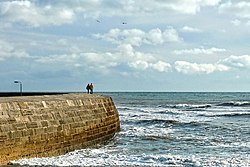
Places of interest
The Cobb
Lyme Regis is well known for "The Cobb", a harbour wall full of character and history. It is an important feature in Jane Austen's novel Persuasion (1818), and in the film The French Lieutenant's Woman, based on the 1969 novel of the same name by local writer John Fowles.
The first written mention of the Cobb is in a 1328 document describing it as having been damaged by storms. The structure was made of oak piles driven into the seabed with boulders stacked between them. The boulders were floated into place tied between empty barrels.
The Cobb was of economic importance to the town and surrounding area, allowing it to develop as both a major port and a shipbuilding centre from the 13th century onwards. Shipbuilding was particularly significant between 1780 and 1850 with around 100 ships launched including a 12-gun Royal Navy brig called HMS Snap.[8] The wall of the Cobb provided both a breakwater to protect the town from storms and an artificial harbour.
Well-sited for trade with France, the port's most prosperous period was from the 16th century until the end of the 18th century, and as recently as 1780 it was larger than Liverpool. The town's importance as a port declined in the 19th century because it was unable to handle the increase in ship sizes.
It was in the Cobb harbour, after the great storm of 1824, that Captain Sir Richard Spencer RN carried out his pioneering lifeboat design work.
A 1685 account describes it as being made of boulders simply heaped up on each other: "an immense mass of stone, of a shape of a demi-lune, with a bar in the middle of the concave: no one stone that lies there was ever touched with a tool or bedded in any sort of cement, but all the pebbles of the see are piled up, and held by their bearings only, and the surge plays in and out through the interstices of the stone in a wonderful manner."
The Cobb has been destroyed or severely damaged by storms several times; it was swept away in 1377 which led to the destruction of 50 boats and 80 houses. The southern arm was added in the 1690s, and rebuilt in 1793 following its destruction in a storm the previous year. This is thought to be the first time that mortar was used in the Cobb's construction. The Cobb was reconstructed in 1820 using Portland Admiralty Roach, a type of Portland stone.
The Cobb also separates Monmouth Beach and Cobb Gate Beach.
Lyme Regis Marine Aquarium
One of the buildings on the Cobb has been converted to house a marine aquarium which displays local fish and marine life from the Jurassic coast. [9]
The Town Mill
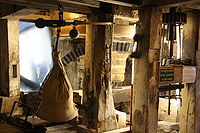
The Town Mill is a watermill dating from 1340, which has been restored to working order and produces flour which is available in its shop.[10] The water comes from the River Lym (also called Lim), which feeds the mill via a "leat". This runs along a terrace or lynch, hence the description of lynch mill. The Domesday Book records the existence of a mill at Lyme in 1086, so the site could be much older. A small brewery, Town Mill Brewery, opened in a part of the Town Mill in March 2010.[11]
St Michael's Church
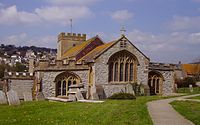
The parish church is St Michael's, on Church Street. Its full title is parish church of St Michael the Archangel. It is situated above Church Cliff and dominates the old town. The church was originally a 12th century tripartite structure including an axial tower but transepts were added ca. 1200 and later in the 13th century two aisles. Early in the 16th century a new church was built east of the tower and transepts and the old chancel and aisles removed. The old nave was shortened in the 19th century.[12]
There are three ways to access the churchyard. From Church Street, enter through the archway and up the steps, next to the Boys' Club or from higher up the hill, direct from Church Street. From Long Entry, there is a steep climb either up steps or up the service road in front of the flats overlooking Lyme Bay. Mary Anning is buried here and there is a stained-glass window dedicated to her memory by members of the Geological Society of London, an organisation that did not admit women until 1904.
Lyme Regis Museum
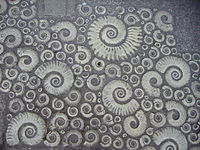
The museum, built on the site of paelontologist Mary Anning's birthplace and family shop off Bridge Street, houses a large collection of local memorabilia, historical items and exhibits explaining the local geological and palaeontological treasures. The museum was formerly known as the Philpot Museum.[13]
Set into the pavement, outside the museum, is an ornate example of Coade stone work, in the form of ammonites, reflecting both local history (Eleanor Coade) and the palaeontology for which the town is famous.
The Dinosaurland Fossil Museum is also located in Lyme Regis in the former church where Mary Anning was baptised.
Lepers Well
On the West bank of the River Lym near the Town Mill is the site of an old chapel "St Mary & the Holy Spirits", known locally as "Lepers Well". The term "Leper" was used as a blanket description of mediæval skin diseases and not necessarily "Leprosy" as it is understood today. There is a small plaque on the wall telling of the hospital which stood on the site 700 years ago. The water still runs today although one assumes in a much reduced flow. Little information survives today, the land was left untouched for many years and some locals can remember livestock being kept on the land before it was landscaped into a visitors' garden in the 1970s.
Three Cups Hotel
The Three Cups Hotel between 15 and 19 Broad Street has associations with many famous literary and historical figures. It is believed that Jane Austen stayed in Hiscott's Boarding house on the same site in 1804.[14] The front section of the current building dates from 1807. The hotel has played host to many famous and influential people including Alfred Lord Tennyson, Henry Wadsworth Longfellow, Hilaire Belloc, G.K. Chesterton and J. R. R. Tolkien who spent several holidays there. In 1944, General Eisenhower delivered an important briefing to senior officers in the first floor lounge prior to D-Day. The building is of significant architectural and historical interest being mentioned in Pevsner's Buildings of England volume on Dorset. The hotel was used in the making of the film The French Lieutenant's Woman in 1981, featuring Jeremy Irons and Meryl Streep. The current owners, Palmers Brewery of Bridport closed the hotel in May 1990 and have announced plans to demolish the significantly historic rear of the building and replace it with retail units, restaurant, visitor and private accommodation.[15]
Royal Lion Hotel
The Royal Lion Hotel is a former coaching inn, dated to the first decade of the 17th century.
Culture
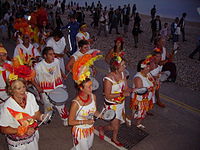
The town has a number of annual events, including the 'Lyme Regis Carnival and Regatta', the Lyme Regis Fossil Festival (in conjunction with the London Natural History Museum) and Mary Anning Day. The traditional conger cuddling event takes place during Lifeboat Week. The carnival and regatta is an event which takes place over a whole week, during August and is organised by a committee of local volunteers. All proceeds from the week will be given to local good causes – especially those supporting the young and the old. The week-long summer programme includes yacht and dinghy racing, power boat rides, parades, open air performances in the shelters, sand based games such as egg catching, events such as the golf ball derby and rubber duck races on the River Lym, carnival procession and fireworks. The Lyme Regis Gig Club regatta also takes place during Carnival Week.
Lyme Regis has a recent history of record breaking attempts, 410 people singing Frère Jacques[16] and largest sand ammonite.[17]
The bonfire night spectacular includes torchlight procession, bonfire on the beach and a firework display. The Christmas Tree Festival has over 30 trees decorated by local organisations in Lyme Regis Baptist Church. An Easter bonnet parade takes place each year in the town on Easter Sunday. A May Day fete has stalls and entertainment from different Lyme groups.
Thanks Giving Day has been held since Parliament decreed at the end of the English Civil War that there should be a day of celebration and prayer in Lyme to commemorate the end of the unsuccessful siege of Lyme by the Royalist forces, which was one of the longest sieges of the Civil War. It is celebrated in Lyme by dressing in clothes of the period and parading through the streets.
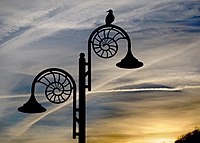
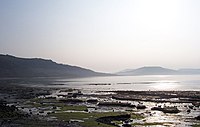
References
- ↑ "Dorset and East Devon Coast". UNESCO World Heritage Centre. 2001. http://whc.unesco.org/pg.cfm?cid=31&id_site=1029. Retrieved 14 January 2007.
- ↑ Ekwall, E. 1981. The Concise Oxford Dictionary of English Place-names (4th edn) Oxford
- ↑ Ordnance Survey 1:25,000 scale Explorer map 29, Lyme Regis & Bridport
- ↑ "Town fears more landslides". BBC News England. 8 January 2003. http://news.bbc.co.uk/1/hi/england/2637895.stm. Retrieved 5 July 2006.
- ↑ The Undercliff. Philpot Museum website, Lyme Regis. Accessed 2006-09-01.
- ↑ "Popular beach reopens for summer". BBC News. 1 July 2005. http://news.bbc.co.uk/1/hi/england/dorset/4640461.stm. Retrieved 5 July 2006.
- ↑ "Landslip is 'worst in 100 years". BBC News. 7 May 2008. http://news.bbc.co.uk/1/hi/england/dorset/7386923.stm. Retrieved 7 May 2008. [Includes video]
- ↑ Fowles John (1991). A Short History of Lyme Regis. Dovecote Press. pp. 34–35. ISBN 0-946159-93-9.
- ↑ Lyme Regis Marine Aquarium
- ↑ http://www.townmill.org.uk/ Town Mill, Lyme Regis
- ↑ "News & Events". www.townmillbrewery.com. http://www.townmillbrewery.com/. Retrieved 2 May 2010.
- ↑ Betjeman, John, ed. (1968) Collins Pocket Guide to English Parish Churches; the South. London: Collins; p. 175
- ↑ Lyme Regis Museum: About Us
- ↑ The (New) Three Cups by Jo Draper, All Over The Town, Journal of The Lyme Regis Society, June 2007
- ↑ Architectural Appraisal and Assessment of Special Interest: Three Cups Hotel, Broad Street, Lyme Regis - Forum Heritage Services (January 2010)
- ↑ hublyme, 2011, frere-jacques
- ↑ Lyme Regis Carnival 2011
Outside links
| ("Wikimedia Commons" has material about Lyme Regis) |
- Lyme Regis Tourism
- Town council
- Geology of Lyme Regis area (Southampton University)
- Landslides at Lyme Regis British Geological Survey
- Lyme Regis at the Open Directory Project
